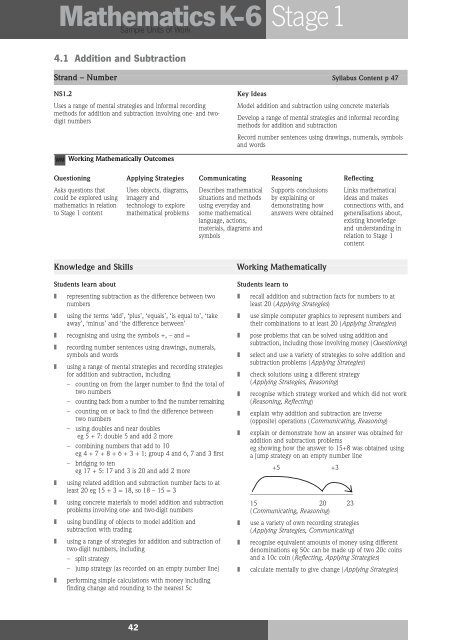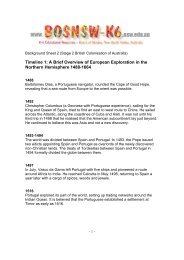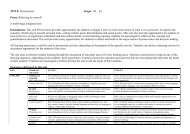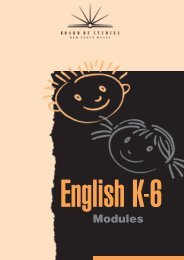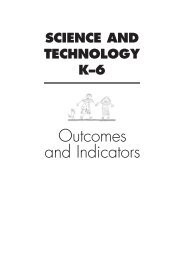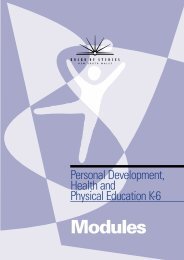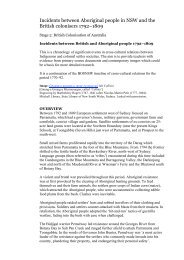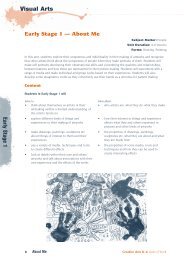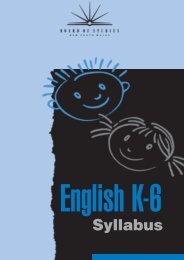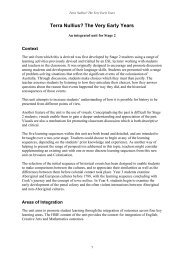Math K-6 WS - K-6 Educational Resources
Math K-6 WS - K-6 Educational Resources
Math K-6 WS - K-6 Educational Resources
Create successful ePaper yourself
Turn your PDF publications into a flip-book with our unique Google optimized e-Paper software.
<strong>Math</strong>ematicsK-6 Stage1<br />
4.1 Addition and Subtraction<br />
Strand – Number Syllabus Content p 47<br />
NS1.2<br />
Uses a range of mental strategies and informal recording<br />
methods for addition and subtraction involving one- and twodigit<br />
numbers<br />
WM<br />
Questioning<br />
Asks questions that<br />
could be explored using<br />
mathematics in relation<br />
to Stage 1 content<br />
Students learn about<br />
Sample Units of Work<br />
Working <strong>Math</strong>ematically Outcomes<br />
Applying Strategies<br />
Uses objects, diagrams,<br />
imagery and<br />
technology to explore<br />
mathematical problems<br />
❚ representing subtraction as the difference between two<br />
numbers<br />
❚ using the terms ‘add’, ‘plus’, ‘equals’, ‘is equal to’, ‘take<br />
away’, ‘minus’ and ‘the difference between’<br />
❚ recognising and using the symbols +, – and =<br />
❚ recording number sentences using drawings, numerals,<br />
symbols and words<br />
❚ using a range of mental strategies and recording strategies<br />
for addition and subtraction, including<br />
– counting on from the larger number to find the total of<br />
two numbers<br />
– counting back from a number to find the number remaining<br />
– counting on or back to find the difference between<br />
two numbers<br />
– using doubles and near doubles<br />
eg 5 + 7: double 5 and add 2 more<br />
– combining numbers that add to 10<br />
eg 4 + 7 + 8 + 6 + 3 + 1: group 4 and 6, 7 and 3 first<br />
– bridging to ten<br />
eg 17 + 5: 17 and 3 is 20 and add 2 more<br />
❚ using related addition and subtraction number facts to at<br />
least 20 eg 15 + 3 = 18, so 18 – 15 = 3<br />
❚ using concrete materials to model addition and subtraction<br />
problems involving one- and two-digit numbers<br />
❚ using bundling of objects to model addition and<br />
subtraction with trading<br />
❚ using a range of strategies for addition and subtraction of<br />
two-digit numbers, including<br />
– split strategy<br />
– jump strategy (as recorded on an empty number line)<br />
❚ performing simple calculations with money including<br />
finding change and rounding to the nearest 5c<br />
Communicating<br />
Key Ideas<br />
Describes mathematical<br />
situations and methods<br />
using everyday and<br />
some mathematical<br />
language, actions,<br />
materials, diagrams and<br />
symbols<br />
Model addition and subtraction using concrete materials<br />
Develop a range of mental strategies and informal recording<br />
methods for addition and subtraction<br />
Record number sentences using drawings, numerals, symbols<br />
and words<br />
Reasoning<br />
Students learn to<br />
Supports conclusions<br />
by explaining or<br />
demonstrating how<br />
answers were obtained<br />
Knowledge and Skills Working <strong>Math</strong>ematically<br />
42<br />
❚ recall addition and subtraction facts for numbers to at<br />
least 20 (Applying Strategies)<br />
❚ use simple computer graphics to represent numbers and<br />
their combinations to at least 20 (Applying Strategies)<br />
❚ pose problems that can be solved using addition and<br />
subtraction, including those involving money (Questioning)<br />
❚ select and use a variety of strategies to solve addition and<br />
subtraction problems (Applying Strategies)<br />
❚ check solutions using a different strategy<br />
(Applying Strategies, Reasoning)<br />
❚ recognise which strategy worked and which did not work<br />
(Reasoning, Reflecting)<br />
❚ explain why addition and subtraction are inverse<br />
(opposite) operations (Communicating, Reasoning)<br />
❚ explain or demonstrate how an answer was obtained for<br />
addition and subtraction problems<br />
eg showing how the answer to 15+8 was obtained using<br />
a jump strategy on an empty number line<br />
+5 +3<br />
______________________________<br />
15 20 23<br />
(Communicating, Reasoning)<br />
Reflecting<br />
❚ use a variety of own recording strategies<br />
(Applying Strategies, Communicating)<br />
Links mathematical<br />
ideas and makes<br />
connections with, and<br />
generalisations about,<br />
existing knowledge<br />
and understanding in<br />
relation to Stage 1<br />
content<br />
❚ recognise equivalent amounts of money using different<br />
denominations eg 50c can be made up of two 20c coins<br />
and a 10c coin (Reflecting, Applying Strategies)<br />
❚ calculate mentally to give change (Applying Strategies)


